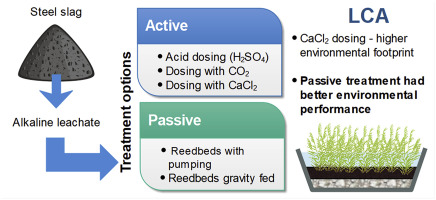Journal of Cleaner Production ( IF 11.1 ) Pub Date : 2018-08-17 , DOI: 10.1016/j.jclepro.2018.08.163 Helena I. Gomes , William M. Mayes , Helen A. Baxter , Adam P. Jarvis , Ian T. Burke , Douglas I. Stewart , Mike Rogerson

|
Management of steel slag (a major by-product of the steel industry) includes the treatment of highly alkaline leachate (pH > 11.5) from rainwater infiltration of slag deposits to prevent adverse impact upon surface or ground waters. This study aims to compare different treatment options for steel slag leachate through a life cycle assessment (LCA). Five options were compared: active treatment by acid dosing (A-H2SO4), active treatment by carbon dioxide dosing (A-CO2), active treatment by calcium chloride dosing (A-CaCl2), passive treatment by cascade and reedbeds with pumping (P-P), and passive treatment by cascade and reedbeds in a gravity-driven configuration (P-G). The functional unit was 1 m3 of treated leachate with pH < 9, considering 24 h and 365 days of operating, maintenance operations every year, and service life of 20 years. Inventory data were obtained from project designers, commercial suppliers, laboratory data and field tests. The environmental impacts were calculated in OpenLCA using the ELCD database and ILCD 2011 method, covering twelve impact categories. The A-CaCl2 option scored worse than all other treatments for all considered environmental impact categories. Regarding human toxicity, A-CaCl2 impact was 1260 times higher than the lowest impact option (A-CO2) for carcinogenics and 53 times higher for non-carcinogenics (A-H2SO4). For climate change, the lowest impact was calculated for P-G < P-P < A-H2SO4 < A-CO2 < A-CaCl2, while for particulate matter/respiratory inorganics, the options ranked as follows P-G < P-P < A-CO2 < A-H2SO4 < A-CaCl2. The major contributor to these impact categories was the Solvay process to produce CaCl2. Higher uncertainty was associated with the categories particulate matter formation, climate change and human toxicity, as they are driven by indirect emissions from electricity and chemicals production. Both passive treatment options had better environmental performance than the active treatment options. Potential design measures to enhance environmental performance of the treatments regarding metal removal and recovery are discussed and could inform operational management at active and legacy steel slag disposal sites.
中文翻译:

碱性钢渣浸出液管理方案:生命周期评估
钢渣的管理(钢铁行业的主要副产品)包括处理雨水渗入矿渣沉积物中的高碱性浸出液(pH> 11.5),以防止对地表水或地下水产生不利影响。本研究旨在通过生命周期评估(LCA)比较钢渣渗滤液的不同处理方案。比较了五个选项:酸加药主动处理(AH 2 SO 4),二氧化碳加药主动处理(A-CO 2),氯化钙加药主动处理(A-CaCl 2),级联和芦苇床被动处理泵送(PP),并在重力驱动配置(PG)中通过级联和芦苇床进行被动处理。功能单元为1 m 3考虑到pH值小于9的经过处理的渗滤液,要考虑24小时和365天的运行,每年的维护操作以及20年的使用寿命。库存数据来自项目设计师,商业供应商,实验室数据和现场测试。在OpenLCA中,使用ELCD数据库和ILCD 2011方法计算了环境影响,涵盖了十二种影响类别。在所有被认为对环境有影响的类别中,A-CaCl 2选件的得分均比所有其他处理差。关于人类毒性,A-CaCl 2对致癌物质的影响比最低影响选项(A-CO 2)高1260倍,对非致癌物质(AH 2 SO 4)则高53倍。)。对于气候变化,计算得出的最低影响是PG <PP <AH 2 SO 4 <A-CO 2 <A-CaCl 2,而对于颗粒物/呼吸性无机物,这些选项的排名如下PG <PP <A-CO 2 <AH 2 SO 4 <A-CaCl 2。这些影响类别的主要贡献者是生产CaCl 2的苏威工艺。较高的不确定性与颗粒物形成,气候变化和人类毒性等类别相关,因为它们是由电力和化学品生产的间接排放所驱动的。两种被动处理方案都比主动处理方案具有更好的环境性能。讨论了用于提高金属去除和回收处理的环境性能的潜在设计措施,这些措施可以为活跃的和遗留的钢渣处置场所的运营管理提供参考。



























 京公网安备 11010802027423号
京公网安备 11010802027423号